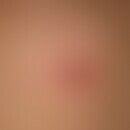DefinitionThis section has been translated automatically.
Autosomal-dominantly inherited (Gandhi et al. 2009) familial autoinflammatory cold syndrome-3 (FCAS3), also known as PLCG2-associated antibody deficiency and immune dysregulation (PLAID) is caused by heterozygous deletions in the PLCG2 gene (600220.0001-600220.0003) on chromosome 16q23 (Ombrello et al. 2012).
ClassificationThis section has been translated automatically.
Like other entities in this family, FACS used to be subsumed under the term "cold urticaria". It has since been recognized that this group of diseases belongs to the hereditary periodic fever syndromes. All these entities are characterized by cold-provoked itchy, burning or slightly painful exanthema (usually limited to the contact site), which can be accompanied by fever attacks and other signs of inflammation. So far, 4 genotypes with slightly different phenotypes have been described, which are now referred to as "cold-induced autoinflammatory syndromes, familial form 1-4":
- Cold-induced autoinflammatory syndrome 1, famil ial (FCAS1) is a hereditary autoinflammatory syndrome caused by a heterozygous mutation in the NLRP3 gene (1q44). FCAS1 is clinically characterized by recurrent episodes (with repeated exposure) of urticarial exanthema associated with arthralgias, myalgias, fever and chills as well as swelling of the extremities after exposure to cold. In rare cases, patients may also develop late-onset renal amyloidosis after decades of progression
- The"cold-induced autoinflammatory syndrome 2, familial" (FCAS2; OMIM: 609648). The autosomal dominant inherited syndrome 2 is caused by heterozygous mutations in the NLRP12 gene (609648).
- The autosomal dominant inherited"cold-induced autoinflammatory syndrome 3, familial" (FCAS3).
- Cold-induced autoinflammatory syndrome 4, familial" (FCAS4) is associated with a heterozygous mutation in the NLRC4 gene (606831) on chromosome 2p22.
You might also be interested in
ClinicThis section has been translated automatically.
Cold-induced autoinflammatory syndrome 3, familial form is an autosomal dominant immunodeficiency characterized by the development of urticarial exanthema associated with pruritus as a loose or systemic reaction to cold exposure. Rarely, blistering occurs. Affected individuals have variable additional immunologic defects, including antibody deficiency, decreased B cell counts, defective B cells, increased susceptibility to infection, and increased risk of autoimmune disease (Ombrello et al. 2012).
Case report(s)This section has been translated automatically.
Gandhi et al (2009) reported on 3 unrelated families with cold urticaria. The patients developed an itchy urticarial exanthema within 5 minutes of exposure to cold, occasionally also angioedema. In most patients, the urticaria began in the first six months of life. The symptoms persisted for life. Subjective improvements in the severity of symptoms occurred after the age of 30 years. Evaporative cold appeared to be the most important trigger, as all patients reported symptoms after exposure to cold. For example, one patient's tear at room temperature led to erythema along the tear line; areas of the body that were warmed in warm water and then exposed to room temperature developed itchy erythema. Skin tests showed that even the evaporation of water droplets led to contact urticaria. Exposure to cold outdoors also led to contact erythema or contact urticaria. In most cases, the local skin reactions subsided within 30 minutes after rewarming.
Triggers were: cold environment (100 %), contact with cold water (92 % and 100 % of patients in the two families), handling cold objects (54 % and 71 %), ingestion of cold food or drink (69 % and 100 %/complicated swelling of the oropharynx). All patients showed itching and urticarial erythema. Angioedema in <50% of patients.
Ombrello et al (2012) reported on three unrelated families with FCAS3. All patients had negative results on skin tests with ice cubes and cold water immersion, but positive results on skin tests for evaporative cooling and general exposure to cold air. In addition, 26 of 27 patients tested had immunologic defects, including antibody deficiency (75%), recurrent infections (56%), and autoantibodies or autoimmune diseases (56%). Laboratory tests revealed reduced IgA and IgM levels in serum, reduced circulating B cells, reduced NK cells. IgE mostly elevated.
LiteratureThis section has been translated automatically.
- Gandhi C et al. (2009) Familial atypical cold urticaria: description of a new hereditary disease. J Allergy Clin Immun 124: 1245-1250.
- Ombrello MJ et al (2012) Cold urticaria, immunodeficiency, and autoimmunity related to PLCG2 deletions. New Eng J Med 366: 330-338.
Incoming links (8)
Familial cold autoinflammatory syndrome 3; Familial cold autoinflammatory syndrome 4; Familial cold-induced autoinflammatory syndrome 2; Familial cold inflammatory syndrome 1; Familial cold urticaria; PID autoinflammatory diseases ; PLCG2 Gene; Primary immunodeficiencies and skin;Outgoing links (5)
Familial cold autoinflammatory syndrome 3; Familial cold autoinflammatory syndrome 4; Familial cold-induced autoinflammatory syndrome 2; Familial cold inflammatory syndrome 1; PLCG2 Gene;Disclaimer
Please ask your physician for a reliable diagnosis. This website is only meant as a reference.




